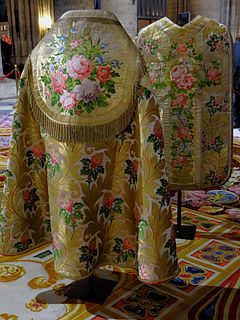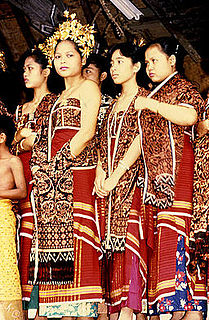
A loom is a device used to weave cloth and tapestry. The basic purpose of any loom is to hold the warp threads under tension to facilitate the interweaving of the weft threads. The precise shape of the loom and its mechanics may vary, but the basic function is the same.
Ikat is a dyeing technique used to pattern textiles that employs resist dyeing on the yarns prior to dyeing and weaving the fabric.

Tablet Weaving is a weaving technique where tablets or cards are used to create the shed through which the weft is passed. As the materials and tools are relatively cheap and easy to obtain, tablet weaving is popular with hobbyist weavers. Currently most tablet weavers produce narrow work such as belts, straps, or garment trims.

A kilim is a flat tapestry-woven carpet or rug traditionally produced in countries of the former Persian Empire, Iran, Azerbaijan and Turkic countries of Central Asia. Kilims can be purely decorative or can function as prayer rugs. Modern kilims are popular floor-coverings in Western households.

Damask is a reversible figured fabric of silk, wool, linen, cotton, or synthetic fibres, with a pattern formed by weaving. Damasks are woven with one warp yarn and one weft yarn, usually with the pattern in warp-faced satin weave and the ground in weft-faced or sateen weave. Twill damasks include a twill-woven ground or pattern.

Double cloth or double weave is a kind of woven textile in which two or more sets of warps and one or more sets of weft or filling yarns are interconnected to form a two-layered cloth. The movement of threads between the layers allows complex patterns and surface textures to be created.

Jamdani is a fine muslin textile of Bengal, produced for centuries in South Rupshi of Narayanganj district in Bangladesh. The historic production of jamdani was patronized by imperial warrants of the Mughal emperors. Under British colonialism, the Bengali jamdani and muslin industries rapidly declined due to colonial import policies favoring industrially manufactured textiles. In more recent years, the production of jamdani has witnessed a revival in Bangladesh. Jamdani is typically woven using a mixture of cotton and gold thread.

Paithani is a variety of sari, named after the Paithan town in Aurangabad Maharashtra state where they are woven by hand. Made from very fine silk, it is considered as one of the richest saris in India. It is one of the most famous saris in India.It is also considered the finest silk in India.

Pile weave is a form of textile created by weaving.These fabrics are characterized by a pile, a looped or tufted surface that extends above the foundation or ground weave. The pile is formed by supplemental yarn running in the direction of the length of the fabric or the width of the fabric. Pile weaves include velvet and corduroy fabrics and machine-woven Berber carpets.

Kasuri (絣) is a Japanese word for fabric that has been woven with fibers dyed specifically to create patterns and images in the fabric. It is an ikat (resist-dyeing) technique. The patterns are characterized by a blurred or brushed appearance. The warp and weft threads are resist-dyed in specific patterns. Prior to dyeing, sections of the warp and weft yarns are tightly wrapped with thread to protect them from the dye. When woven together, the undyed areas interlace to form patterns. Many variations are possible. Kasuri patterns may be applied to the warp or to the weft; or to both the warp and the weft. There are many techniques used to create kasuri. The cloth is classified with different names depending on the method used.

A selvage or selvedge is a "self-finished" edge of fabric, keeping it from unraveling and fraying. The term "self-finished" means that the edge does not require additional finishing work, such as hem or bias tape, to prevent fraying.

Silk in the Indian subcontinent is a luxury good. In India, about 97% of the raw mulberry silk is produced in the five Indian states of Karnataka, Andhra Pradesh, Tamil Nadu, West Bengal and Jammu and Kashmir. Mysore and North Bangalore, the upcoming site of a US$20 million "Silk City", contribute to a majority of silk production. Another emerging silk producer is Tamil Nadu where mulberry cultivation is concentrated in Salem, Erode and Dharmapuri districts. Hyderabad, Andhra Pradesh and Gobichettipalayam, Tamil Nadu were the first locations to have automated silk reeling units.

Brocade is a class of richly decorative shuttle-woven fabrics, often made in colored silks and with or without gold and silver threads. The name, related to the same root as the word "broccoli", comes from Italian broccato meaning "embossed cloth", originally past participle of the verb broccare "to stud, set with nails", from brocco, "small nail", from Latin broccus, "projecting, pointed".

The sampot is a long, rectangular cloth worn around the lower body. It can be draped and folded in several different ways. The traditional dress is similar to the dhoti of Southern Asia. It is also worn in the neighboring countries of Laos and Thailand where it is known as pha nung.

A knotted-pile carpet is a carpet containing raised surfaces, or piles, from the cut off ends of knots woven between the warp and woof. The Ghiordes/Turkish knot and the Senneh/Persian knot, typical of Turkish carpets and Persian carpets, are the two primary knots. A flat or tapestry woven carpet, without pile, is a kilim. A pile carpet is influenced by width and number of warp and weft, pile height, knots used, and knot density.

Soumak is a tapestry technique of weaving strong and decorative textiles used as rugs and domestic bags. Baks used for bedding are known as Soumak Mafrash. Soumak is a type of flat weave, somewhat resembling but stronger and thicker than kilim, with a smooth front face and a ragged back, where kilim is smooth both sides. Soumak lacks the slits characteristic of kilim, as it is usually woven with supplementary weft threads as continuous supports.
Bhutanese textiles represent a rich and complex repository of a unique art form. They are recognised for their abundance of colour, sophistication and variation of patterns, and the intricate dyeing and weaving techniques. The weavers, who are mostly women, must not be seen merely as creator of wealth but also as the innovators and owners of artistic skills developed and nurtured over centuries of time.




















